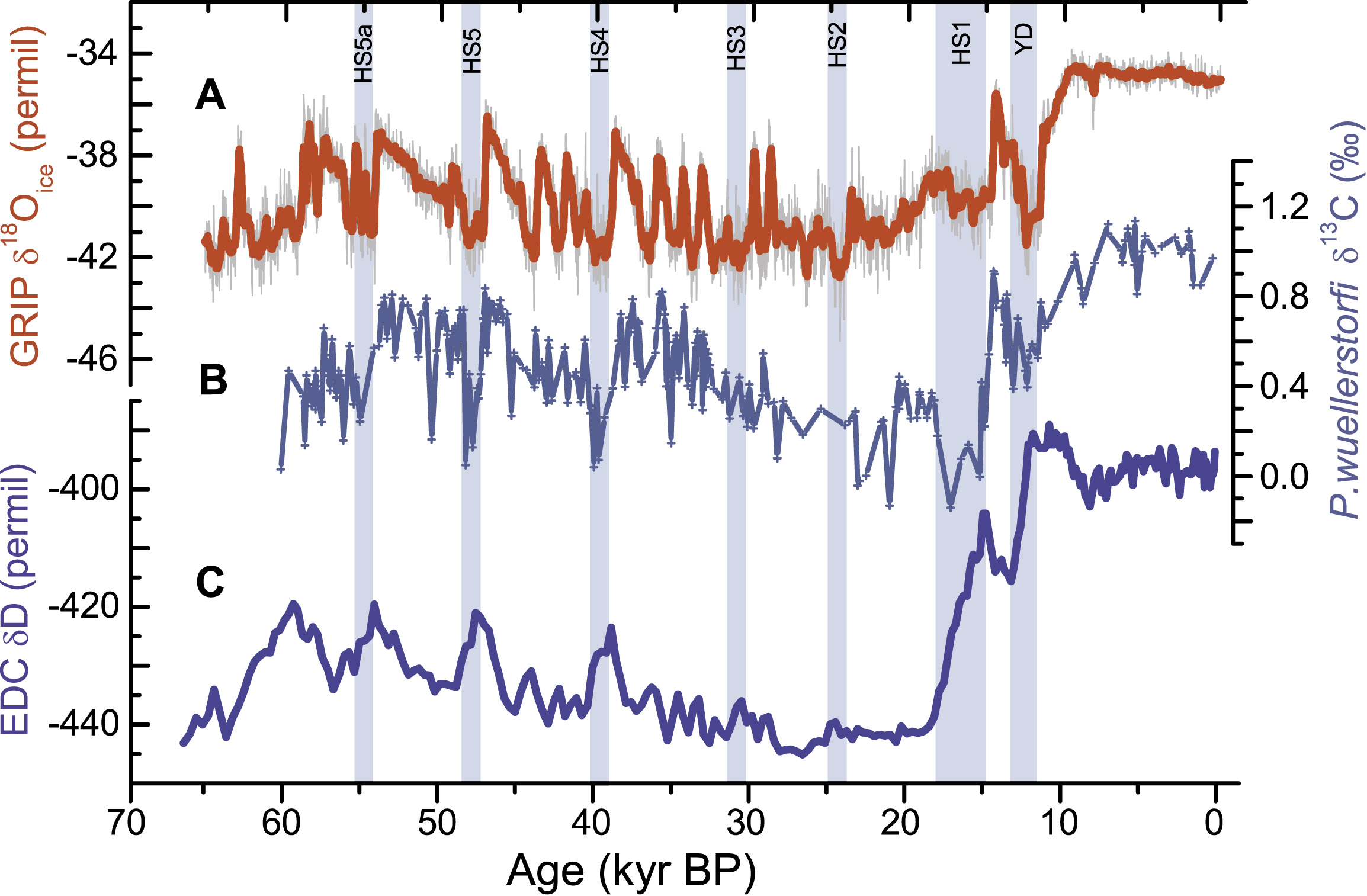- Home
- Publications
- PAGES Magazine
- Ocean Circulation - Does Large-scale Ocean Overturning Circulation Vary With Climate Change? [Past]
Ocean circulation - Does large-scale ocean overturning circulation vary with climate change? [Past]
PAGES news
20(1)
15
2012
Luke Skinner
Department of Earth Sciences, University of Cambridge, UK; lcs32 cam.ac.uk
cam.ac.uk
A foundational geological concept that is attributed to James Hutton, the principle of “uniformitarianism”, holds that the present is the key to the past. However, the observable present cannot capture the full dynamic range of the climate system, and it is therefore to the past that we must turn for a broader perspective on climate change. What is clear from the geological record is that the large-scale ocean circulation is not immutable; it has changed repeatedly in the past and in intimate connection with global and regional climate shifts. What is generally less clear, is exactly what aspect of the ocean circulation has changed in each instance (mass transport, interior mixing rates, transport pathways?), to what degree, and why. These ambiguities arise from two principle challenges in paleoceanography: first, the challenge of inferring hydrographic observations from ”proxies”; and second, the challenge of inferring the ocean’s large-scale circulation from sparse hydrographic observations, often with highly uncertain age-control. These difficulties become exacerbated when attempting to reconstruct analogues of the relatively subtle, high frequency or seasonally expressed changes in the ocean circulation that are likely to be most relevant to climate change in the decades to come.
Perhaps the most robust case study in past ocean-climate linkages comes from the last 60 ka. This time period has witnessed a succession of regional climate changes, with Greenland and the North Atlantic region exhibiting rapid warm/cold alternations in association with coupled but asynchronous changes in Antarctic temperature. The largest of these climatic perturbations also coincide with changes in the chemistry of waters filling the deep Atlantic (Fig. 1B). The latter are most easily attributed to shifts in the distribution of different water-masses, and therefore to changes in the ocean circulation; a view that is broadly consistent with some numerical model simulations (Ganopolski and Rahmstorf 2001; Liu et al. 2009).
The prevailing interpretation of the records shown in Figure 1 is that they represent the operation of a ”thermal bipolar seesaw”, resulting from changes in the ”effectiveness” of the Atlantic overturning circulation as a heat pump from southern to northern latitudes (Schmittner et al. 2003). The hypothesized trigger for these overturning perturbations is anomalous melt-water supply to the North Atlantic: i.e. ice-sheet or ice-shelf surges that may well have been climatically driven (Alvarez-Solas et al. 2010; Flückiger et al. 2006). Interestingly, the patterns and associations of these rapid ocean-climate changes appear to be consistent with an overturning circulation that is conditionally stable, and that may respond non-linearly to relatively subtle perturbations, depending on the prevailing climate/forcing conditions (Margari et al. 2009; Rahmstorf et al. 2005). Indeed, through their inter-hemispheric teleconnections and their inferred impact on the carbon cycle (Anderson et al. 2009), such non-linear shifts in the ocean circulation are thought to have played a key role in tipping global climate out of its glacial state ca. 15-20 ka ago (Barker et al. 2011). Once this happened, ocean-climate variability appears to have become more subdued. Although this suggests a relative stabilization of the ocean circulation under interglacial conditions, it does not imply the complete elimination of ocean-climate variability during the Holocene. Indeed, evidence exists for centennial to millennial perturbations during the Holocene that are likely to have dwarfed those recorded in the instrumental record.
What can these impressive, if incompletely understood, changes in the past ocean-climate system teach us? In general, they question the paradigm of the ocean circulation as a millennially sluggish flywheel in the climate system. They suggest a capacity to respond sensitively to, and in turn impact significantly on regional and global climate, possibly in a non-linear fashion and with important ramifications for the carbon cycle and the global energy budget. However, the past does not provide an easy template for the future. If the geological record is to inform more directly on the stability properties of our modern circulation and its immediate future, paleoceanographers will need to focus on past ocean-climate variability in increasingly fine detail, and with a particular emphasis on relatively warm climate conditions.
selected references
Full reference list online under: http://pastglobalchanges.org/products/newsletters/ref2012_1.pdf
Alvarez-Solas J et al. (2010) Nature Geoscience 3: 122-126
Anderson RF et al. (2009) Science 323: 1443-1448
Barker S et al. (2011) Science 334: 347-351
Margari V et al. (2009) Nature Geoscience 3(2): 127-131
Schmittner A et al. (2003) Quaternary Science Reviews 22: 659-671
